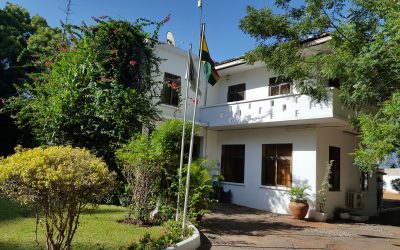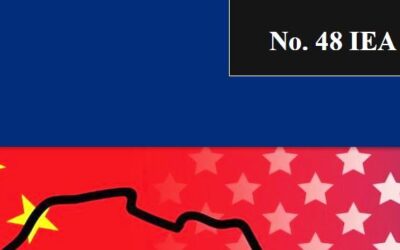The Ghana Policy Journal (GPJ) is a multi disciplinary publication of the Institute of Economic Affairs (IEA), Accra Ghana, which is Ghana’s first Think Tank established in 1989. The journal is sponsored by the International Department Research Centre Think Thank Initiative. The journal was launched in Accra, Ghana on the 25th of July 2017 by then the Chief Advisor to the President of the Republic of Ghana Dr. (Mrs.) Mary Chinery Hesse as part of the Commemoration of Ghana’s 50th Independence Anniversary.
The GPJ is an interdisciplinary and multidisciplinary peer-reviewed journal which intends to provide a forum for the presentation and discussion of views from a wide range of scholars dealing with policy related issues concerning Ghana, and Ghana’s link and relationship with the rest of the world. The Journal particularly encourages quantitative and empirical studies with results and conclusions that are relevant to policy formulation and analyses. Studies that provide viewpoints on economic development paths are particularly encouraged. The Journal accepts the following types of research: original articles, case studies, and policy analysis and normative
EDITORIAL BOARD
Prof. J. Atsu Amageshie, University of Guelph, Ontario, Canada.
Dr. Francis Bilson Darku, Université of Notre Dame, Notre Dame, USA
Prof. Eugenia Amporfu, Kwame Nkrumah University of Science and Technology, Kumasi, Ghana.
Dr. James Obben, Massey University, Palmerston North, New Zealand.
Prof Yaw Debra, University of Wales, Swansea, United Kingdom.
Dr. Nahomi Ichino, Harvard University, Cambridge, MA, United States.
Prof. Frank Ohemeng, Concordia University, Montréal, Canada.
Prof. Pascal Ghazalian, University of Lethbridge, Lethbridge, Canada.
1. The manuscripts must be word-processed in Time New Roman, including charts, figures, and graphs. Equations should be presented using Microsoft Word Equation Editor. The main body text should be in a font size 12 and footnotes in size 10. There should be a line spacing of 1.5 between paragraphs and headings in the main body and line space 1.0 in the foot notes. Word for word quotes must be put in double quotes and italicized with a 0.5 indent. The entire document, including footnotes, must be justified.
2. All submitted papers should be typed on one side of paper and single-spaced including references and endnotes. Endnotes are preferred to footnotes.
3. Submitted papers should include a separate title page indicating the title of the paper, the names of the authors and their institutional affiliations and the postal and electronic mail addresses of the corresponding author(s).
4. An abstract of up to 300 words should be provided in a separate page after the title page. The abstract should contain a list of three to ten keywords inserted at the bottom of the abstract.
5. For verification of empirical works, the paper should be accompanied by a computer disk with data files that can allow a reviewer to independently replicate the construction of the data and the results of the analysis.
6. The authors of submitted papers should indicate in their covering letter to the Editor that their paper is an original work and that the paper has not been published and is not being submitted to any other outlet for publication.
7. Submission of a manuscript implies: that the work has not been published elsewhere; that it is not under consideration for publication elsewhere; that all Co-authors, if any, have approved the submission.
8. The referencing style should follow the Harvard format. For example: (Mensa, 2005) or (see Kufour, 2006, pp. 18 – 20). The references should be listed alphabetically by author at the end of the paper based on the following examples:
For a journal article
Hensher, D., Shore, N and Train, K. (2006) “Investment in Intangible Capital: An Enterprise Perspective”, Economic Record, 82, pp. 56 – 66.
For a book:
Pearce, D. and Barbier, E.B. (2000) Blueprint for a Sustainable Economy, Earthscan, London, 273 pp.
For a chapter in a book
Mohammed, S. J. and Anaman, K.A. (2003) “Analysis of the Health and Environmental Quality Adjusted Gross Domestic Product in Brunei Darussalam”, in K. A. Anaman and Duraman, I. (eds.), Applied Economic Analysis in Brunei Darussalam: Evaluation of Economic Growth and Trade, Microeconomic Efficiency and Analysis of Socio-economic Problems, Universiti Brunei Darussalam, Bandar Seri Begawan, pp. 47 – 66.
For a reference from a website
Association of Southeast Asian Nations (ASEAN) (2003) “Asean Statistics”, (Jakarta, Asean), http://www.aseansec.org/13000.htm.
9. The layout of the paper in terms of major headings should be as follows”
(a) Title Page
(b) ABSTRACT
(c ) INTRODUCTION AND PROBLEM STATEMENT
(d) LITERATURE REVIEW
(e) THEORETICAL MODELS (if required)
(f) METHODOLOGY
(g) RESULTS (if required)
(h) DISCUSSION AND POLICY IMPLICATIONS OF STUDY
(i) CONCLUSIONS (briefly written in a few paragraphs)
(j) ACKNOWLEDGEMENTS
(k) ENDNOTES
(k) REFERENCES
(l) APPENDICES (including major data if necessary)
Subheadings may be used and should have capital letters at the beginning of a word. For example, under the major heading, “INTRODUCTION AND PROBLEM STATEMENT”, a subheading may be “Objectives of the Study” or “Organisation of this Paper”.
How to Submit
Manuscripts should be sent preferably by email to the Editor of the Ghana Policy Journal:
Prof. Alexander Bilson Darku (alexander.darku@uleth.ca).
I hope you will consider submitting your paper for review by the GPJ.
Cordially,
Prof. Alexander Bilson Darku
Editor, GPJ.
The Ghana Policy Journal (GPJ) invites all researchers to submit their research papers for publication in the Journal’s June 2023 issue. The GPJ is the flagship international journal of the IEA, published under the guidance of Prof. Alexander Bilson Darku (Editor) and an eminent international Editorial Board. Published annually, it serves as a forum for the presentation and discussion of views from a wide range of scholars dealing with policy related issues concerning Ghana, and Ghana’s link and relationship with the rest of the world. The Journal particularly encourages quantitative and empirical studies with results and conclusions relevant to policy formulation and analyses.
We are inviting papers for the Volume 7 issue of the Journal to be released in June, 2023. For this seventh issue of GPJ, contributed papers should reach the Editor by the 28th February, 2023. Authors will be informed of the final status of refereeing of their papers by the 30th April, 2023.
The GPJ is indexed in the electronic databases of the American Economic Association including EconLit, the largest economics database in the world. An annotation of the Journal was published in the New Books Section of the September 2007 issue of the Journal of Economic Literature. Abstracts of all papers published in the Journal appear in EconLit. For listing of the Ghana Policy Journal on the Internet database of journals, please check the following website: http://www.econlit.org/eclist.html#jnlg
Contributed papers should be written in English language and deal with issues in anthropology, business, economics, education, entrepreneurship, geography, history, law, music, political science, religion, sports, sociology and any other social sciences, and topics involving natural sciences with some policy orientation.
The Journal accepts papers which uses either qualitative or quantitative methods but must have some policy orientation. The length of a contributed paper should be between 4,000 to 10,000 words. Letters to the Editor or short notes (about 1,000 words) are also encouraged, in which contributors present comments on papers previously published or on issues of current relevance and importance.
All manuscripts must be accompanied by an abstract of not more than 300 words. All correspondence must be via email to the editor at alexander.darku@uleth.ca
INSTRUCTION FOR AUTHORS
1. Authors should use Microsoft Word only. All text must be in Times New Roman, including charts, figures, and graphs. Equations should be presented using Microsoft Word Equation Editor.
2. All submitted papers should be typed on one side of paper and single-spaced including references and endnotes. Endnotes are preferred to footnotes.
3. Submitted papers should include a separate title page indicating the title of the paper, the names of the authors and their institutional affiliations and the postal and electronic mail addresses of the corresponding author(s).
4. An abstract of up to 300 words should be provided in a separate page after the title page. The abstract should contain a list of three to ten keywords inserted at the bottom of the abstract.
5. For verification of empirical works, the paper should be accompanied by a computer disk with data files that can allow a reviewer to independently replicate the construction of the data and the results of the analysis.
6. The authors of submitted papers should indicate in their covering letter to the Editor that their paper is an original work and that the paper has not been published and is not being submitted to any other outlet for publication.
7. Submission of a manuscript implies: that the work has not been published elsewhere; that it is not under consideration for publication elsewhere; that all Co-authors, if any, have approved the submission.
8. The referencing style should follow the Harvard format. For example: (Mensa, 2005) or (see Kufour, 2006, pp. 18 – 20). The references should be listed alphabetically by author at the end of the paper based on the following examples:
For a journal article
Hensher, D., Shore, N and Train, K. (2006) “Investment in Intangible Capital: An Enterprise Perspective”, Economic Record, 82, pp. 56 – 66.
For a book:
Pearce, D. and Barbier, E.B. (2000) Blueprint for a Sustainable Economy, Earthscan, London, 273 pp.
For a chapter in a book
Mohammed, S. J. and Anaman, K.A. (2003) “Analysis of the Health and Environmental Quality Adjusted Gross Domestic Product in Brunei Darussalam”, in K. A. Anaman and Duraman, I. (eds.), Applied Economic Analysis in Brunei Darussalam: Evaluation of Economic Growth and Trade, Microeconomic Efficiency and Analysis of Socio-economic Problems, Universiti Brunei Darussalam, Bandar Seri Begawan, pp. 47 – 66.
For a reference from a website
Association of Southeast Asian Nations (ASEAN) (2003) “Asean Statistics”, (Jakarta, Asean), http://www.aseansec.org/13000.htm.
8. The layout of the paper in terms of major headings should be as follows”
(a) Title Page
(b) ABSTRACT
© INTRODUCTION AND PROBLEM STATEMENT
(d) LITERATURE REVIEW
(e) THEORETICAL MODELS (if required)
(f) METHODOLOGY
(g) RESULTS (if required)
(h) DISCUSSION AND POLICY IMPLICATIONS OF STUDY
(i) CONCLUSIONS (briefly written in a few paragraphs)
(j) ACKNOWLEDGEMENTS
(k) ENDNOTES
(k) REFERENCES
(l) APPENDICES (including major data if necessary)
Subheadings may be used and should have capital letters at the beginning of a word. For example under the major heading, “INTRODUCTION AND PROBLEM STATEMENT”, a subheading may be “Objectives of the Study” or “Organisation of this Paper”.





0 Comments